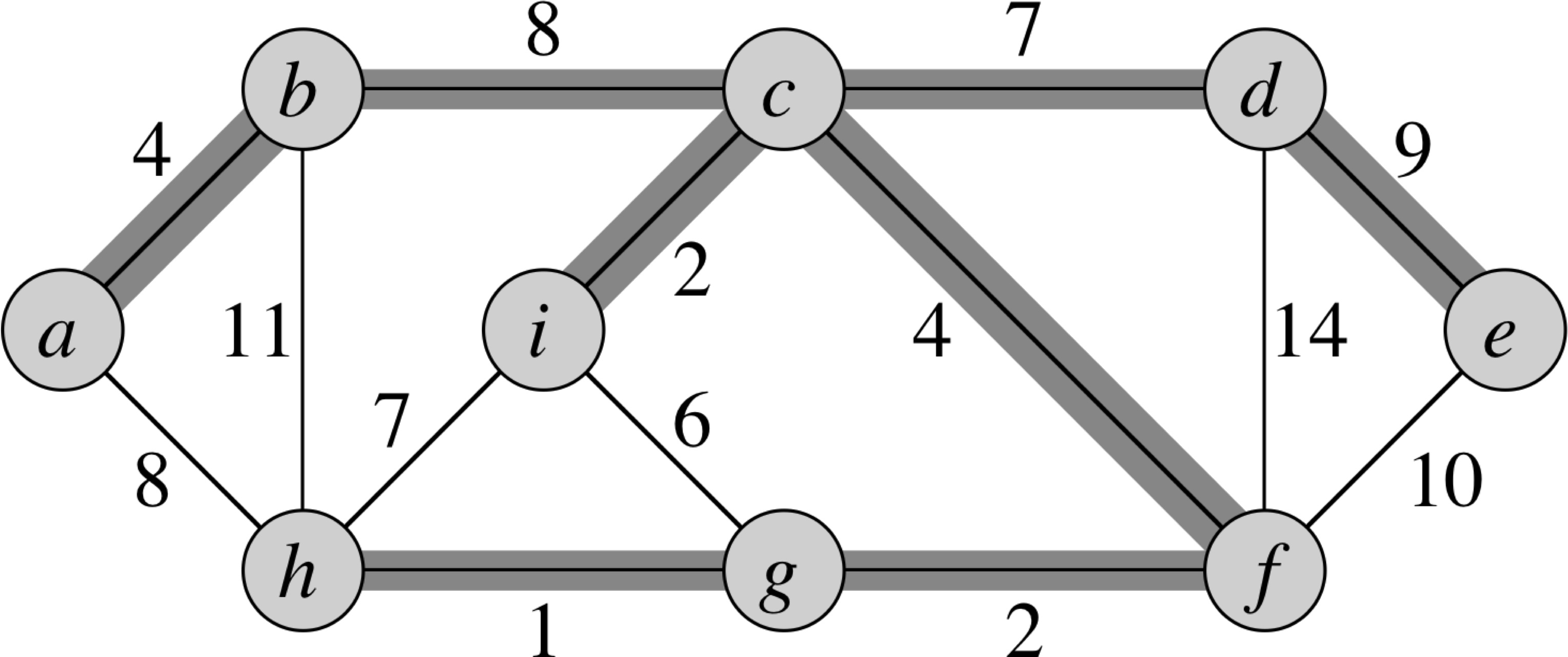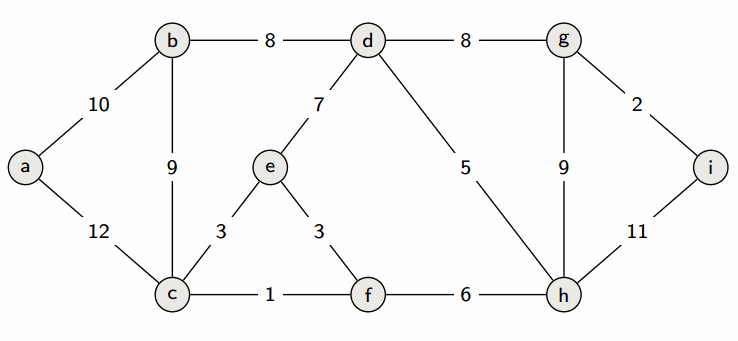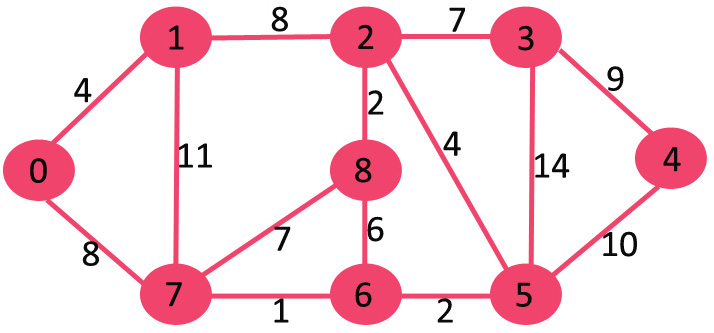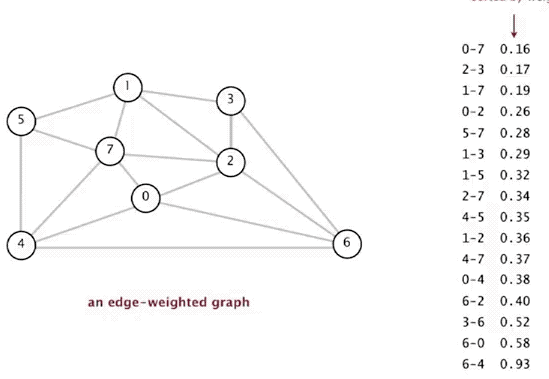## Minimum Spanning Trees # Continued --- CS 137 // 2021-11-01 <!--=====================================================================--> ## Administrivia - <!--=====================================================================--> # Questions ## ...about anything? <!--=====================================================================--> # Minimum Spanning Trees <!-- .slide: data-background="#004477" --> <!--=====================================================================--> ## Weighted Graphs - Recall that a *weighted graph* has numerical values, called weights, assigned to each edge <div class='jekyll-diagrams diagrams graphviz'> <!-- Generated by graphviz version 2.43.0 (0) --> <!-- Title: dfa Pages: 1 --> <svg width="389pt" height="119pt" viewBox="0.00 0.00 389.00 119.00" xmlns="http://www.w3.org/2000/svg" xmlns:xlink="http://www.w3.org/1999/xlink"> <g id="graph0" class="graph" transform="scale(1 1) rotate(0) translate(4 115)"> <title>dfa</title> <polygon fill="white" stroke="transparent" points="-4,4 -4,-115 385,-115 385,4 -4,4"/> <!-- a --> <g id="node1" class="node"> <title>a</title> <ellipse fill="none" stroke="black" cx="27" cy="-72" rx="27" ry="18"/> <text text-anchor="middle" x="27" y="-68.3" font-family="Times,serif" font-size="14.00">a</text> </g> <!-- b --> <g id="node2" class="node"> <title>b</title> <ellipse fill="none" stroke="black" cx="354" cy="-92" rx="27" ry="18"/> <text text-anchor="middle" x="354" y="-88.3" font-family="Times,serif" font-size="14.00">b</text> </g> <!-- a--b --> <g id="edge1" class="edge"> <title>a--b</title> <path fill="none" stroke="black" d="M51.55,-79.81C58.11,-81.75 65.28,-83.66 72,-85 88.22,-88.25 92.52,-87.58 109,-89 189.3,-95.92 209.44,-97.76 290,-100 298.44,-100.23 300.59,-100.76 309,-100 315.19,-99.44 321.8,-98.45 327.98,-97.35"/> <text text-anchor="middle" x="190.5" y="-99.8" font-family="Times,serif" font-size="14.00">5</text> </g> <!-- c --> <g id="node3" class="node"> <title>c</title> <ellipse fill="none" stroke="black" cx="245" cy="-69" rx="27" ry="18"/> <text text-anchor="middle" x="245" y="-65.3" font-family="Times,serif" font-size="14.00">c</text> </g> <!-- a--c --> <g id="edge2" class="edge"> <title>a--c</title> <path fill="none" stroke="black" d="M54.05,-71.64C95.57,-71.06 176.28,-69.94 217.85,-69.36"/> <text text-anchor="middle" x="136" y="-73.8" font-family="Times,serif" font-size="14.00">7</text> </g> <!-- d --> <g id="node4" class="node"> <title>d</title> <ellipse fill="none" stroke="black" cx="136" cy="-18" rx="27" ry="18"/> <text text-anchor="middle" x="136" y="-14.3" font-family="Times,serif" font-size="14.00">d</text> </g> <!-- a--d --> <g id="edge4" class="edge"> <title>a--d</title> <path fill="none" stroke="black" d="M45.9,-59C53.7,-53.66 63.07,-47.65 72,-43 84.73,-36.37 99.64,-30.38 111.75,-25.93"/> <text text-anchor="middle" x="81.5" y="-46.8" font-family="Times,serif" font-size="14.00">13</text> </g> <!-- c--b --> <g id="edge3" class="edge"> <title>c--b</title> <path fill="none" stroke="black" d="M270.82,-74.33C287.98,-78.02 310.73,-82.91 327.95,-86.61"/> <text text-anchor="middle" x="299.5" y="-84.8" font-family="Times,serif" font-size="14.00">11</text> </g> <!-- d--c --> <g id="edge5" class="edge"> <title>d--c</title> <path fill="none" stroke="black" d="M160.12,-26.18C172.2,-30.71 187.11,-36.68 200,-43 208.29,-47.06 217.1,-52.11 224.65,-56.68"/> <text text-anchor="middle" x="190.5" y="-46.8" font-family="Times,serif" font-size="14.00">17</text> </g> </g> </svg> </div> <!--=====================================================================--> ## Spanning Trees - Given an undirected, connected, graph $G=(V,E)$, a **spanning tree** is a connected subgraph $T = (V,E')$ with $E'\subseteq E$ with no cycles  <!--=====================================================================--> ## Minimum Spanning Tree - **Input**: A connected, weighted, undirected graph $G = (V,E)$ with weights $w:E\rightarrow\mathbb{R}_{>0}$ - **Output**: a tree $T = (V,E')$ where $E'\subseteq E$ so that $\\sum_\{e\\in E'\} w(e)$ is minimized <!----------------------------------> ## Minimum Spanning Trees - Finding the **minimum spanning tree** (**MST**) is extremely useful for a lot of problems  <!--=====================================================================--> # Prim's Algorithm <!-- .slide: data-background="#004477" --> <!--=====================================================================--> ## Prim's Algorithm - Prim's approach to find an MST is **greedy** - <!-- .element: class="fragment"--> The main idea is to build up a partial MST and keep choosing the **cheapest** edge out of the tree that doesn't create a cycle <!----------------------------------> ## Prim's Visualization  <!----------------------------------> ## Prim's Pseudocode 1. <!-- .element: class="fragment"--> Let $x\in V$ be an arbitrary vertex in $G = (V,E)$ 2. <!-- .element: class="fragment"--> Set $S = \\{x\\}$ and $E' = \emptyset$ 3. <!-- .element: class="fragment"--> While $S \ne V$, do the following: 1. <!-- .element: class="fragment"--> Let $(u,v)\in E$ be the cheapest edge satisfying $u\in S$ and $v\not\in S$ 2. <!-- .element: class="fragment"--> Add $(u,v)$ to $E'$ and $v$ to $S$ 4. <!-- .element: class="fragment"--> Return $T = (V,E')$ <!--=====================================================================--> ## Is Prim's Correct? - <!-- .element: class="fragment"--> Since it is always adding a disconnected vertex to the blob, it will never create a cycle + <!-- .element: class="fragment"--> Thus, it definitely returns a spanning tree - <!-- .element: class="fragment"--> Is the spanning tree *minimal* though? <!----------------------------------> ## Proof by Contradiction - Assume that it is possible for Prim's to return a sub-optimal MST - <!-- .element: class="fragment"--> Let $G = (V,E)$ be a graph where Prim's fails - <!-- .element: class="fragment"--> Since the algorithm returns a spanning tree that is not minimal, let $(x,y)$ be the first edge added by Prim's that differs from the MST <!----------------------------------> ## Proof by Contradiction  - Since $(x,y)$ is not in the MST of $G$, there must be some other path from $x$ to $y$ in the MST - <!-- .element: class="fragment"--> Let $(v_1, v_2)$ be the edge that connects the two subgraphs in the MST along this path <!----------------------------------> ## Proof by Contradiction  - Since Prim's selected $(x, y)$ instead of $(v_1, v_2)$, exchanging this edge for $(x,y)$ yields a spanning tree of lesser weight - <!-- .element: class="fragment"--> Thus, Prim's actually *did* return an MST! <!--=====================================================================--> ## How fast is Prim's Algorithm? - Depends on what data structure is used - <!-- .element: class="fragment"--> If we do a linear search for the cheapest edge every time, the runtime is $O(nm)$ - <!-- .element: class="fragment"--> If we employ a min-heap data structure, it can be improved to $O(m\log m)$ - <!-- .element: class="fragment"--> With an even fancier data structure, it can be improved to $O(m + n\log n)$ <!--=====================================================================--> # Kruskal's Algorithm <!-- .slide: data-background="#004477" --> <!--=====================================================================--> ## Kruskal's Algorithm 1. Sort the edges of $G$ in increasing order of weight 2. For each edge $e$ in this order: 1. Add $e$ to $T$ if it connects two components in $T$ 3. Return $T$ <!----------------------------------> ## Kruskal's Algorithm  <!----------------------------------> ## Kruskal's Algorithm Visualization  <!--=====================================================================--> ## Is Kruskal's Correct? - It keeps adding edges without creating a cycle, so it does produce a spanning tree with $n-1$ edges - <!-- .element: class="fragment"--> Is it minimal though? <!----------------------------------> ## Proof by Contradiction - Assume that it is possible for Kruskal's to return a sub-optimal MST - Let $G = (V,E)$ be a graph where Kruskal's fails - Since the algorithm returns a spanning tree that is not minimal, let $(x,y)$ be the first edge added by Kruskal's that differs from the MST <!----------------------------------> ## Proof by Contradiction - If we add $(x,y)$ to the true MST of $G$ it creates a cycle between vertices $x$ and $y$ - <!-- .element: class="fragment"--> Now, if we delete the cheapest edge along the cycle we should minimize the cost - <!-- .element: class="fragment"--> But the minimum cost edge in the cycle is $(x,y)$, otherwise Kruskal's would have selected it first - <!-- .element: class="fragment"--> Thus, Kruskal's returns an MST after all! <!--=====================================================================--> ## How Fast is Kruskal's? 1. Sort the edges of $G$ in increasing order of weight 2. For each edge $e$ in this order: 1. Add $e$ to $T$ if it connects two components in $T$ 3. Return $T$ --- - <!-- .element: class="fragment"--> Sorting edges takes $O(m\log m)$ - <!-- .element: class="fragment"--> Loop runs $m$ times - <!-- .element: class="fragment"--> We could use BFS to check if two vertices are connected already, but that takes $O(n+m)$-time + <!-- .element: class="fragment"--> Can we do better? <!--=====================================================================--> # Union-Find <!-- .slide: data-background="#004477" --> <!--=====================================================================--> ## Union-Find Data Structure - What we need is a data structure that supports two operations: 1. **Find(x)**: returns the component $x$ belongs to 2. **Union(x,y)**: merges the components of $x$ and $y$ - <!-- .element: class="fragment"--> Ideally, each of these operations should take at most $O(\log n)$ <!----------------------------------> ## Union-Find Implementation - **Idea:** Use a *forest*, i.e., collection of trees! + <!-- .element: class="fragment"--> Elements are leaves + <!-- .element: class="fragment"--> Roots are the "label" of the component that the element belongs to + <!-- .element: class="fragment"--> Merge labels by combining trees <!---------------------------------->  <!----------------------------------> ## Union-Find Runtime - Both operations are $O(\log n)$ if we union by making the smaller tree a subchild of the taller tree + <!-- .element: class="fragment"--> Tree only gets taller when two subtrees are the same size + <!-- .element: class="fragment"--> Each operation requires starting from a leaf and finding the root <!--=====================================================================--> ## Overall Runtime of Kruskal's - Becomes $O(m\log n)$ because find/union operations run once per execution of the loop - <!-- .element: class="fragment"--> Thus, Kruskal's is similar to Prim's in runtime